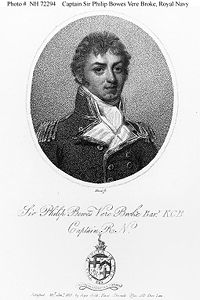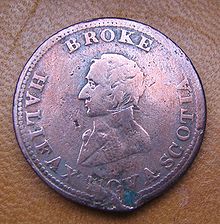- Philip Broke
-
For other people named Philip Broke, see Philip Broke (disambiguation).
Philip Broke 
Sir Philip Bowes Vere BrokeBorn 9 September 1776
Nacton, near Ipswich, EnglandDied 2 January 1841 (aged 64) Allegiance  United Kingdom
United KingdomService/branch  Royal Navy
Royal NavyYears of service 1792 - Rank Rear-Admiral Battles/wars Battle of Cape St. Vincent, 1797
Capture of USS Chesapeake, 1813Awards Order of the Bath
Naval Gold MedalRear Admiral Sir Philip Bowes Vere Broke, 1st Baronet KCB (
 /ˈbrʊk/;[1] 9 September 1776 – 2 January 1841) was a distinguished officer in the British Royal Navy.
/ˈbrʊk/;[1] 9 September 1776 – 2 January 1841) was a distinguished officer in the British Royal Navy.Contents
Early life
Broke was born at Broke Hall, Nacton, near Ipswich, the eldest son of Philip Bowes Broke. He attended Ipswich School where a house has now been named in his honour.
Broke joined the Royal Naval Academy at Portsmouth Dockyard in 1788, and began active service as a midshipman in 1792. It was rather unusual for him to receive formal naval education — most of his contemporaries had only "on the job" training. He served as third lieutenant on the frigate HMS Southampton during the Battle of Cape St. Vincent in February 1797. He was promoted to commander in 1799 and captain on 14 February 1801.[2]
He married Sarah Louisa Middleton on 25 November 1802. They had 11 children.
Capture of USS Chesapeake
Main article: Capture of USS ChesapeakeHis most notable accomplishment was his victory while commanding HMS Shannon, over the USS Chesapeake on 1 June 1813, during the War of 1812. Broke took command of the Shannon, a 38-gun frigate, on 31 August 1806. Broke was ordered to Halifax, Nova Scotia in 1811 as the diplomatic position between America and Britain deteriorated. US President James Madison declared war on 18 June 1812. There were half a dozen naval battles between a Royal Naval and a United States Navy vessel of equivalent rate in 1812 and early 1813. The Americans won every time, primarily because although the British and American ships were of the same rate, they were not of the same size or power. In each case the American ships were substantially larger than the British vessels and had a heavier broadside (the Americans had a main battery of 24 pounder long guns compared with the smaller 18 pounders mounted on the British ships).
Matters changed when Shannon defeated Chesapeake as it attempted to evade the blockade of Boston, Massachusetts. Although Chesapeake was a slightly larger craft and had a substantially larger crew, gunnery was Broke's area of expertise, and the crew of Shannon were exceptionally well drilled.[3] Chesapeake was disabled by gunfire, boarded and captured within 15 minutes of opening fire. 56 sailors on Chesapeake were killed and 85 wounded including her captain James Lawrence who died of his wounds on 4 June. Lawrence's last command was reported to be, "Don't give up the ship". On the Shannon, 24 were killed and 59 wounded, including Broke who sustained a serious head wound while leading the boarding party.
Lieutenant Provo Wallis took command of Shannon as the frigate and her prize returned to Halifax as surgeons worked to save Broke. In Halifax, Broke recovered at the Commissioner's residence in the Halifax Naval Yard.
Shannon's victory created a sensation in both the US and England. In recognition, Broke was created a baronet on 25 September 1813.[4][5] He became a Knight Commander of the Order of the Bath on 3 January 1815.[6][7] He was also awarded a Naval Gold Medal, one of only eight awarded for single ship actions between 1794 and 1816. While his wounds precluded further active service, Broke served as a naval gunnery specialist in the Royal Navy. He was promoted to Rear Admiral of the Red on 22 July 1830.
His younger brother, Charles Broke, later Charles Broke Vere, joined the British Army, serving under the Duke of Wellington, ending up as a Major General and was knighted.
Broke in Fiction
A fictionalized account of Shannon's battle with Chesapeake is featured prominently in Patrick O'Brian's novels The Fortune of War and The Surgeon's Mate. Broke, whom O'Brian makes a cousin to his protagonist Captain Jack Aubrey, is favorably portrayed as a character in the former work, and receives prominent mention in the second.
Notes
- ^ G.M. Miller, BBC Pronouncing Dictionary of British Names (Oxford UP, 1971), p. 21.
- ^ The Navy List, 1831
- ^ At the time the official rating of a ship did not accurately reflect the number of cannon mounted. Thus HMS Shannon (1053 tons burthen) was classed as a 38 gun ship but mounted 52 guns in total. USS Chesapeake (1244 tons burthen) was variously rated a 36 or 38 gun ship but mounted 49 guns in total. Although Shannon had slightly more cannon the disparity was more apparent than real as Broke mounted a number of very small carronades in order that ships' boys and younger midshipmen could have cannon light enough for them to practise on. The force of a ship was usually calculated as "weight of metal." This was the aggregate of the weight of all the cannonballs capable of being fired in one broadside (ie when half of the cannon (all the guns on the same side) were fired). The British weight of metal was 547 pounds, the American weight of metal was 581 pounds. The two ships were very well matched with no preponderance of force on either side. See Padfield and Gardiner.
- ^ London Gazette: no. 16779. p. 1890. 21 September 1813. Retrieved 2008-02-05.
- ^ London Gazette: no. 16852. p. 280. 5 February 1814. Retrieved 2008-02-05.
- ^ London Gazette: no. 16972. p. 19. 4 January 1815. Retrieved 2008-02-05.
- ^ London Gazette: no. 17032. p. 1277. 1 July 1815. Retrieved 2008-02-05.
References
- Biography at the Dictionary of Canadian Biography Online
- Brief biography
- Broke's letter reporting Shannon's victory over Chesapeake.
- Description of the significance of the battle.
- Admiral Sir P. B. V. Broke ...: a memoir, published 1866, now at GoogleBooks.
- Dictionary of National Biography, 1885-1900, Volume 06, now at Wikisource.
- Press release relating to his Gold Naval Medal (DCMS, 19 January 2006)
- History of Nova Scotia, "The Shannon and the Chesapeake," Part 1 and Part 2
- A Suffolk Naval Hero.
- Gardiner, R. (2000). Frigates of the Napoleonic Wars, Chatham Publishing. ISBN 1-86176-135-X
- Padfield, P. (1968). Broke and the Shannon, London: Hodder and Stoughton
Baronetage of the United Kingdom New creation Baronet
(of Broke Hall)
1813–1841Succeeded by
Sir Philip BrokeCategories:- 1776 births
- 1841 deaths
- Baronets in the Baronetage of the United Kingdom
- Royal Navy admirals
- British naval personnel of the French Revolutionary Wars
- British naval personnel of the War of 1812
- People from Suffolk Coastal (district)
- Knights Commander of the Order of the Bath
- Old Ipswichians
Wikimedia Foundation. 2010.

